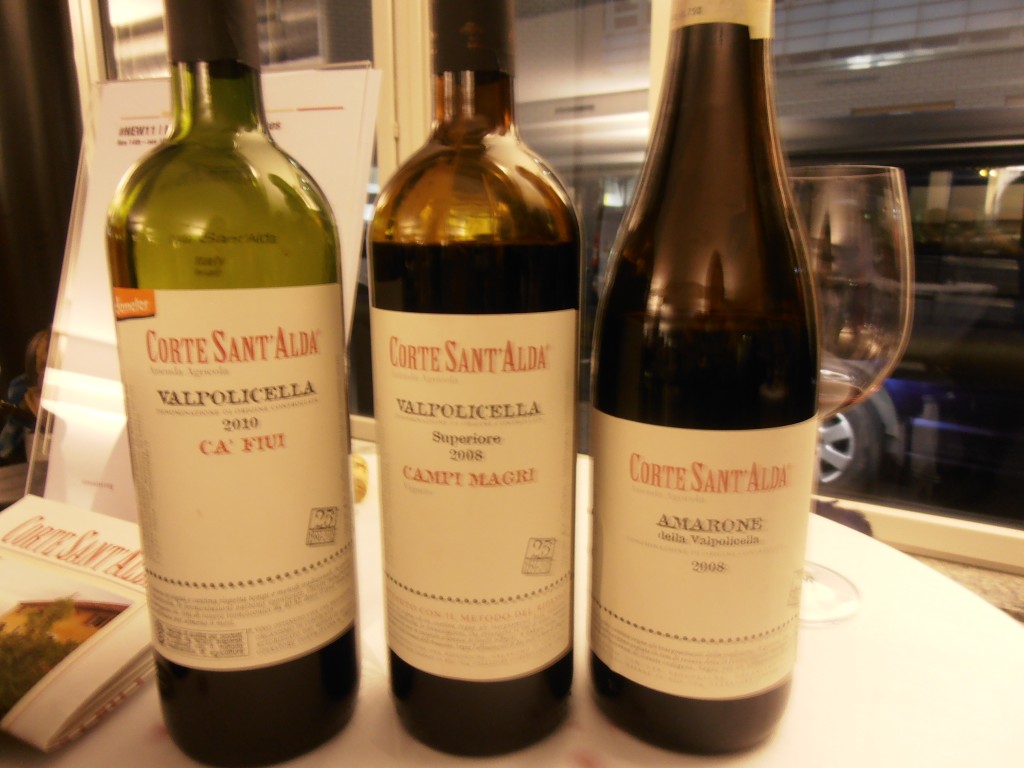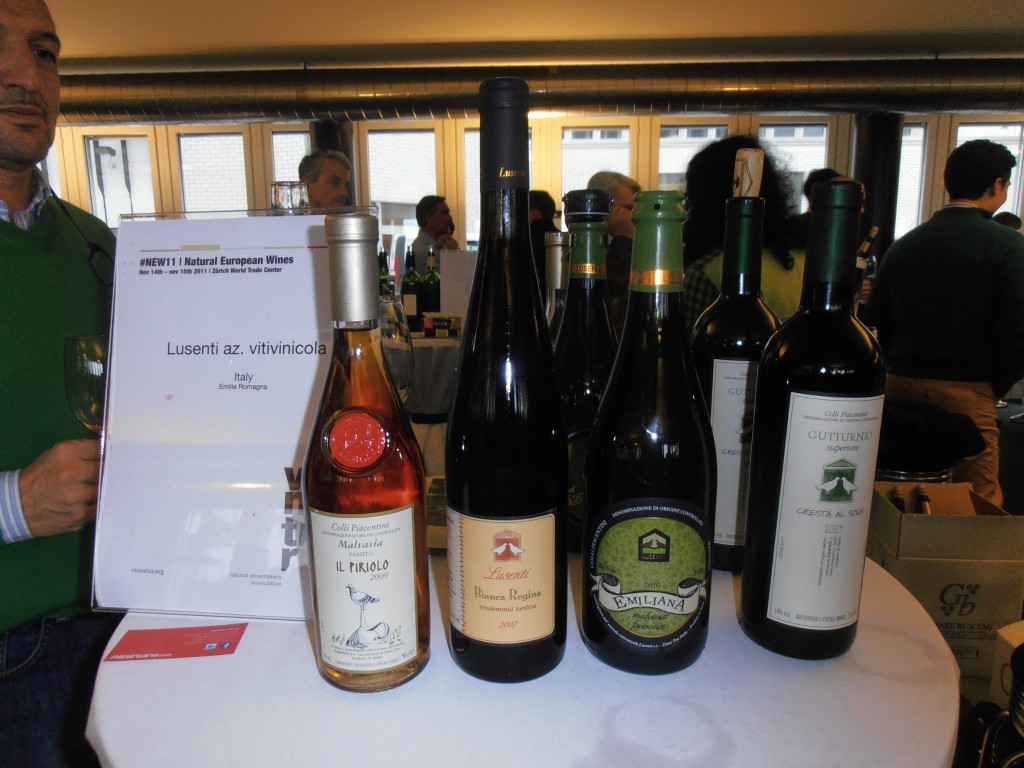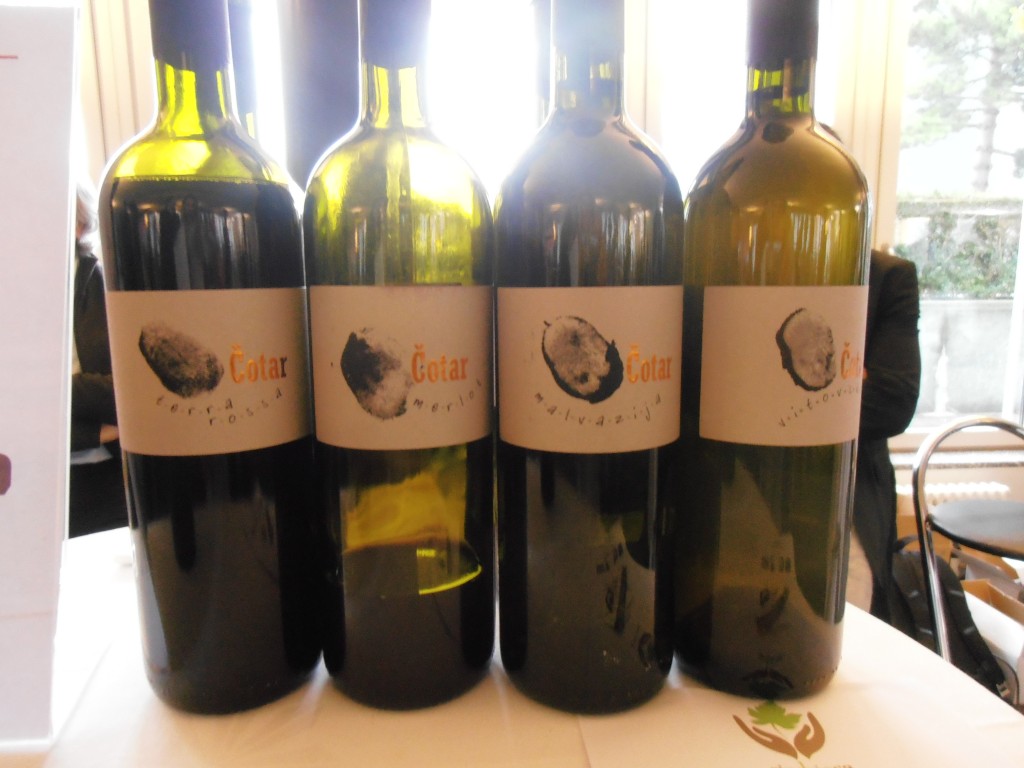After my report about the actual Natural European Wines Conference (#NEW11) organised by VinNatur, it is now time to talk about the tasting. I had thoroughly enjoyed the conference and was really looking forward to now taste some prime examples of Natural Terrior Wines!
The #NEW11 tasting was open to the public from 3 pm till 6 pm on Monday the 14th November and from 9.30 am till 6 pm on Tuesday 15th November 2011. The entrance fee was 20 € or 25 CHF per person a real bargain as consumers had the opportunity to taste wines from 98 producers from 9 different countries (Portugal, Spain, France, Switzerland, Austria, Italy, Slovenia, Croatia and Serbia)
I spend about 5 hours (over 2 days) at the tasting yet still only managed to cover about 1/3 of the wines there. It was really interesting to be able to taste with the producers and to ask precise questions. Again this tasting felt like a winery visit, as the consumer got the undivided attention of the vigneron whilst tasting, with some vignerons even offering tank samples when they could sense a genuine interest. It was definitely THE place to discover different natural winemakers, compare styles and truly find out the “story” behind each bottle. I learned so much about the specific terroirs, specific wine making techniques used to produce the wines and difficulties encountered. I have rarely met a bunch of more passionate people and was totally invigorated after the tasting. It is one of the few occasions where I have seen people really help each other (there sometimes were some language barriers) and recommend other producers “you just have to try”. Maybe that is why I ran out of time in the end before I managed to taste my way through the room. If anything this is definitely a reason to return next year and I would suggest that true natural wine aficionado’s definitely put this tasting on their calendar!
I would like to talk a little about a few wineries that particularly stood out for me. The first one being Corte Sant’ Alda, where the very charismatic Marinella Camerani talked me through her wines. Corte Sant’ Alda was established 25 years ago by Marinella who owns about 15 hectares of vineyards near the town of Mezzane at the foothills of the Lessini Mountains in Veneto. Corte Sant’ Alda is known for it’s Valpolicellas, all made according to the classic blend of Molinara, Rondinella and Corvina. All grapes are hand picked and Marinella explained that the “cantina” (winery) is located in the middle of the vineyard in order to process the fruit as close to picking as possible. The vineyards are certified organic and Corte Sant’ Alda is currently in the process of converting to bio-dynamic farming. All fermentation is natural and induced by the indigenous yeast on the skins.
I tasted the the following wines:
Corte Sant’ Alda Valpolicella Ca’Fiui 2010 : nice bouquet of violets and red fruit; An elegant medium bodied wine, with lots of red berries and a hint of violet and a little leather and fine grain tanins in the nicely balanced finish.
Corte Sant’ Alda Valpolicella Superiore Campi Magri 2008: A fresh, dry, fruit forward Valpolicella Ripassa , with lost of ripe cherry flavours and a hint of sweet liquorice and fine grain tanins in the long finish. This wine is made in the traditional style ie by adding some semi fermented Valpolicella to the Amarone skins. After fermentation the Ripassa is aged for 18 months in large cherry wood barrels.
Corte Sant’ Alda Amarone della Valpolicella Campi Magri 2008: A complex red fruit nose, with a hint of liquorice and cloves. Dry, fresh and elegant wine which shows lovely saline/mineral character. Lots of red plums and cherries in the middle palate, with some fennel, liquorice, cloves and cedar in the long finish. Even though the wine tasted lovely I believe to see the true beauty and potential of this Amarone it should be cellared for 3-5 years. It was one of the nicest Amarone’s I have tasted in a very long time and I will be on the look out for a bottle next time I travel to the UK :-)
Corte Sant’Alda in imported in the UK by Berry Bros. & Rudd.
Valli Unite is a co-operative set up originally more than 30 years ago by 4 families in Costa Vescovato in Piedmont. Today membership has grown to 25. Valli Unite focusses on a whole range of organic farming including cattle raising, crop farming and viticulture. They have 10 wine labels and each label, each wine, tells a different story…
I tasted the following 4 wines:
San Vito da uve Timorasso 2009: Timorasso is an indigenous white grape variety from the valleys of Borbera, Curone, Grue and Ossona and is very scarce these days. In the light of biodiversity the co-operative planted a few hectares of it a few years back. The resulting wine is a full bodied yet crisp floral wine which reminded me a little of a dry Vouvray. The interesting thing was a hint of some dried sage and laurel leaf in the finish.
Diogene da uve Dolcetto 2008: Fresh, dry floral red wine with flavours of Peony, Rose and wild strawberries,with and an interesting astringency in the finish.
Gaitu Barbera 2008: Crisp elegant wine with lots of black fruit, (mulberry) and fine grain tanin.
Vighe Barberra DOC 2007:: Complex red wine with integrated tanin, with lots of black forest fruit (blackberry, wild blue berry), a smokey characteristic and a little tar and spice in the finish.
Valli Unite also runs an Agritursmo and a bio-shop. Some of the Valli Unite wines are distributed in the US by Savio Sellections.
The very enthusiastic Giuseppe Ferri introduced me to the Lusenti wines. The Lusenti winery has been run by him and his wife Lodovica Lussenti since Lodovica inherited the property which is based in the Val Tidone in Emilia Romana from her parent in the early 1990’s. Lusenti are currently in the process of getting organically certified, however they have been working the land in an organic way for some time now. In the winery only indigenous yeast are used.
Both Giuseppe and Lodovica are very passionate about their land – they feel it is the land in combination with the climate which allows them to make a unique terroir wine. The importance for them lies in the expression of nature which means that wines may differ from year to year. Lusenti are part of the Mosaico Piacentino Consortium a group of 6 wineries who got together to promote the quality wines made in the Coli Piacentini area. Their wines are exported top Japan, Poland, Norway, Germany and the UK.
I tasted the following wines:
Emiliana Malvasia Frisanta 2010: A dry crisp aromatic wine with very fine bubbles and rich flavours of ripe apple and a little flintiness in the finish. This wine is bottled keeping it’s natural yeast from the lees. The second fermentation occurs naturally and will gradually dissolve the fine lees giving the wine its complexity and finesse.
Gutturnio Superiore “Cresta al Sole” 2007: This wine is a blend of 60% Barbera and 40 % Croatina. The grapes are hand harvested and processed separately. No yeast is added during fermentation which takes place in stainless steel vats and takes 2 to 3 weeks. The caps are pushed down twice a day during this period. Once fermentation has finished, the wines are blended and racked into oak barriques where they will go through malolactic fermentation and age for at least 12 months. The wine is not filtered before bottling, and once in bottle this wine is aged for another 12 months. The result is a well balanced fruit forward easy drinking wine, with some dark plum and blackberry in the middle palate and clove, cedar and a little pink pepper in the long finish.
Malvasia Passito “Il Piriolo” 2009: This Malvasia comes from a vineyard with silty, clay soils with some lime stone streaks. The grapes are hand picked towards the end of august and put into crates which will dry in the sun for about 2 months. After drying the bunches are pressed in traditional vertical presses and the must is left to ferment and mature in small wooden casks for 10 months. Once bottled the wine is aged for another 6 months before it is released to the market. It’s a luscious, complex low alcohol (about 9%) wine with great acidity and rich flavours of roasted hazelnut, sultana and prunes in the middle palate and flinty notes in the long finish. It is a perfect wine to finish a meal, and it would pair very well with cheese or creamy nutty deserts.
Giuseppe pointed me toward the Slovenian tables telling me that they made some lovely and fresh wines and I really should go and try them. When learned that the 4 wineries which make up Simbiosa are located in Kras (Carso) I became really excited as I had read great things about Carso wines from my EWBC colleagues who had visited some Carso wineries on the Trieste (Italy) post trip in October. And indeed I was not disappointed to have visited the Slovenian tables as the wines were simply excellent :-) What really impressed me the most was that all wines I tasted had aged extensively yet showed a remarkable youthful character. They were fresh, well balanced and most of them would continue to develop more complexity with age. Tasting the Slovenian wines once again reinforced for me that natural wines can age beautifully under the right conditions!
My favourite Slovenian winery, Cotar Vasja was established by Branko Cotar about 30 years ago when the family was still running a very successful restaurant. After a while the Cotars totally fell in love with grape farming and wine making and decided to sell the restaurant and dedicate themselves 100% to the grapes and wine instead :-) Cotar Vasja are another fine example of a terroir wine. Branko explained to me that they are dedicated to organic farming as he feels it is the only way they can express the all the beauty of the Kars ancient volcanic soils.
I tasted:
Coter Vasja Vitovska 2007: Vitovska is an indigenous Kars white grape variety. The grapes were hand picked and de-stemmed. Fermentation took place on the skins for about 7 days. Then the wine was racked and aged in cask for 3 years before bottling. The Vitovska 2007 is a fresh and elegant wine with wonderful weight and floral notes of passion fruit flower and a little guava in the middle palate and a flinty almost saline mineral finish.
Coter Vasja Malvasia 2006: The vinification of the Malvasia is similar to the Vitovska. I was blown away by the freshness of this 2006 Malvasia. Again the wine was very rounded, with floral Jasmin notes, ripe red apple and quince in the middle palate and a spicy long finish.
Coter Vasja Merlot 2004: The wine underwent a 15-20 day maceration on the skins, before being racked into cask and aged for 6 years before bottling. Yet again the wine was fresh and youthful and Branko referred to it as being “just a baby” :-) Dry, high acid wine with velvety and integrated tanins, lots of blueberry and wild raspberry flavours, a hint of rosemary and some mineral notes showing an almost iron like character, some black coffee and all spice in the long finish.
Coter Vasja Terra Rosa 2003: A blend of 40% Merlot, 20% Cabernet Sauvignon and 40% Terran. The grapes were hand picked and macerated separately during 15-20 days, the wines were then racked, blended and aged in oak casks for 6 years.The Terra Rosa had a complex and round nose showing hints of ripe cherry and some firework smoke. Again the wine was very youthful and fresh with a velvet tanin structure, good body and flavours of dark cherry, a little mulberry, some ripe black plum, a little nutmeg and sage in the mineral and smokey finish.
Cotar Vasja is imported in the US by Louis/Dressner Selections.



